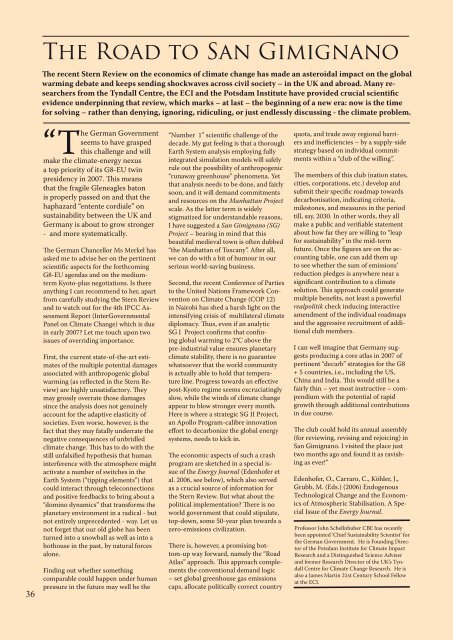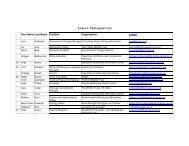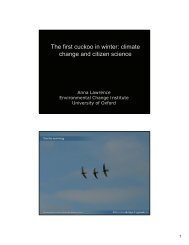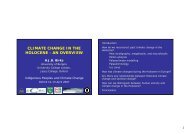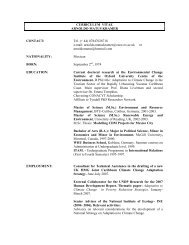ECI Annual Review 2006/2007 - Environmental Change Institute ...
ECI Annual Review 2006/2007 - Environmental Change Institute ...
ECI Annual Review 2006/2007 - Environmental Change Institute ...
You also want an ePaper? Increase the reach of your titles
YUMPU automatically turns print PDFs into web optimized ePapers that Google loves.
6<br />
The Road to San Gimignano<br />
The recent Stern <strong>Review</strong> on the economics of climate change has made an asteroidal impact on the global<br />
warming debate and keeps sending shockwaves across civil society – in the UK and abroad. Many researchers<br />
from the Tyndall Centre, the <strong>ECI</strong> and the Potsdam <strong>Institute</strong> have provided crucial scientific<br />
evidence underpinning that review, which marks – at last – the beginning of a new era: now is the time<br />
for solving – rather than denying, ignoring, ridiculing, or just endlessly discussing - the climate problem.<br />
German Government<br />
seems to have grasped<br />
“The<br />
this challenge and will<br />
make the climate-energy nexus<br />
a top priority of its G8-EU twin<br />
presidency in <strong>2007</strong>. This means<br />
that the fragile Gleneagles baton<br />
is properly passed on and that the<br />
haphazard “entente cordiale” on<br />
sustainability between the UK and<br />
Germany is about to grow stronger<br />
- and more systematically.<br />
The German Chancellor Ms Merkel has<br />
asked me to advise her on the pertinent<br />
scientific aspects for the forthcoming<br />
G8-EU agendas and on the mediumterm<br />
Kyoto-plus negotiations. Is there<br />
anything I can recommend to her, apart<br />
from carefully studying the Stern <strong>Review</strong><br />
and to watch out for the 4th IPCC Assessment<br />
Report (InterGovernmental<br />
Panel on Climate <strong>Change</strong>) which is due<br />
in early <strong>2007</strong>? Let me touch upon two<br />
issues of overriding importance.<br />
First, the current state-of-the-art estimates<br />
of the multiple potential damages<br />
associated with anthropogenic global<br />
warming (as reflected in the Stern <strong>Review</strong>)<br />
are highly unsatisfactory. They<br />
may grossly overrate those damages<br />
since the analysis does not genuinely<br />
account for the adaptive elasticity of<br />
societies. Even worse, however, is the<br />
fact that they may fatally underrate the<br />
negative consequences of unbridled<br />
climate change. This has to do with the<br />
still unfalsified hypothesis that human<br />
interference with the atmosphere might<br />
activate a number of switches in the<br />
Earth System (“tipping elements”) that<br />
could interact through teleconnections<br />
and positive feedbacks to bring about a<br />
“domino dynamics” that transforms the<br />
planetary environment in a radical - but<br />
not entirely unprecedented - way. Let us<br />
not forget that our old globe has been<br />
turned into a snowball as well as into a<br />
hothouse in the past, by natural forces<br />
alone.<br />
Finding out whether something<br />
comparable could happen under human<br />
pressure in the future may well be the<br />
“Number 1” scientific challenge of the<br />
decade. My gut feeling is that a thorough<br />
Earth System analysis employing fully<br />
integrated simulation models will safely<br />
rule out the possibility of anthropogenic<br />
“runaway greenhouse” phenomena. Yet<br />
that analysis needs to be done, and fairly<br />
soon, and it will demand commitments<br />
and resources on the Manhattan Project<br />
scale. As the latter term is widely<br />
stigmatized for understandable reasons,<br />
I have suggested a San Gimignano (SG)<br />
Project – bearing in mind that this<br />
beautiful medieval town is often dubbed<br />
“the Manhattan of Tuscany”. After all,<br />
we can do with a bit of humour in our<br />
serious world-saving business.<br />
Second, the recent Conference of Parties<br />
to the United Nations Framework Convention<br />
on Climate <strong>Change</strong> (COP 12)<br />
in Nairobi has shed a harsh light on the<br />
intensifying crisis of multilateral climate<br />
diplomacy. Thus, even if an analytic<br />
SG I Project confirms that confining<br />
global warming to 2ºC above the<br />
pre-industrial value ensures planetary<br />
climate stability, there is no guarantee<br />
whatsoever that the world community<br />
is actually able to hold that temperature<br />
line. Progress towards an effective<br />
post-Kyoto regime seems excruciatingly<br />
slow, while the winds of climate change<br />
appear to blow stronger every month.<br />
Here is where a strategic SG II Project,<br />
an Apollo Program-calibre innovation<br />
effort to decarbonize the global energy<br />
systems, needs to kick in.<br />
The economic aspects of such a crash<br />
program are sketched in a special issue<br />
of the Energy Journal (Edenhofer et<br />
al. <strong>2006</strong>, see below), which also served<br />
as a crucial source of information for<br />
the Stern <strong>Review</strong>. But what about the<br />
political implementation? There is no<br />
world government that could stipulate,<br />
top-down, some 50-year plan towards a<br />
zero-emissions civilization.<br />
There is, however, a promising bottom-up<br />
way forward, namely the “Road<br />
Atlas” approach. This approach complements<br />
the conventional demand logic<br />
– set global greenhouse gas emissions<br />
caps, allocate politically correct country<br />
quota, and trade away regional barriers<br />
and inefficiencies – by a supply-side<br />
strategy based on individual commitments<br />
within a “club of the willing”.<br />
The members of this club (nation states,<br />
cities, corporations, etc.) develop and<br />
submit their specific roadmap towards<br />
decarbonisation, indicating criteria,<br />
milestones, and measures in the period<br />
till, say, 2030. In other words, they all<br />
make a public and verifiable statement<br />
about how far they are willing to “leap<br />
for sustainability” in the mid-term<br />
future. Once the figures are on the accounting<br />
table, one can add them up<br />
to see whether the sum of emissions’<br />
reduction pledges is anywhere near a<br />
significant contribution to a climate<br />
solution. This approach could generate<br />
multiple benefits, not least a powerful<br />
realpolitik check inducing interactive<br />
amendment of the individual roadmaps<br />
and the aggressive recruitment of additional<br />
club members.<br />
I can well imagine that Germany suggests<br />
producing a core atlas in <strong>2007</strong> of<br />
pertinent “decarb” strategies for the G8<br />
+ 5 countries, i.e., including the US,<br />
China and India. This would still be a<br />
fairly thin – yet most instructive – compendium<br />
with the potential of rapid<br />
growth through additional contributions<br />
in due course.<br />
The club could hold its annual assembly<br />
(for reviewing, revising and rejoicing) in<br />
San Gimignano. I visited the place just<br />
two months ago and found it as ravishing<br />
as ever!”<br />
Edenhofer, O., Carraro, C., Köhler, J.,<br />
Grubb, M. (Eds.) (<strong>2006</strong>) Endogenous<br />
Technological <strong>Change</strong> and the Economics<br />
of Atmospheric Stabilisation. A Special<br />
Issue of the Energy Journal.<br />
Professor John Schellnhuber CBE has recently<br />
been appointed ‘Chief Sustainability Scientist’ for<br />
the German Government. He is Founding Director<br />
of the Potsdam <strong>Institute</strong> for Climate Impact<br />
Research and a Distinguished Science Adviser<br />
and former Research Director of the UK’s Tyndall<br />
Centre for Climate <strong>Change</strong> Research. He is<br />
also a James Martin 21st Century School Fellow<br />
at the <strong>ECI</strong>.


